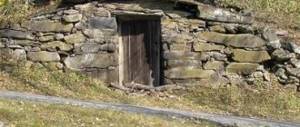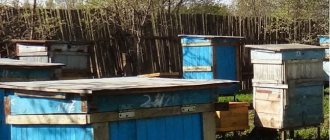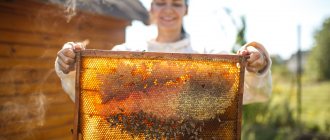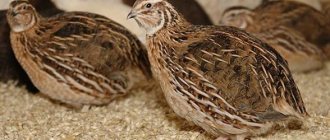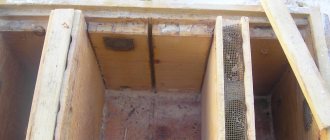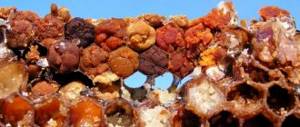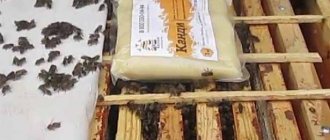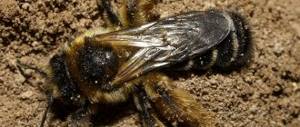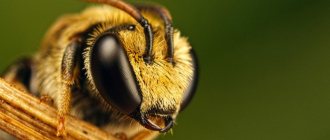Many honey lovers who want to start their own apiary are faced with the problem of arranging hives and a lack of information on the topic. To start working in beekeeping science, you can choose a simple and ancient method - log beekeeping. This line of activity is the closest to natural; it allows you to experiment and not spend a lot of time caring for the apiary.
Let's look at the main features of working with logs on the site and the principle of arranging such houses, and how to build a fence for bees with your own hands. These recommendations will allow you to collect your first honey harvest.
The log and modern beekeeping
The deck is an ancient method of obtaining honey, which is convenient and simple. Due to the spacious volume of the home and its durability, it can accommodate a large family. The bees are provided with maximum comfort and produce more honey. This is an economical and simple method, accessible even to beginners.
All work with the log comes down to the fact that you need to clean the hollow in the spring and take out part of the honey reserves in the fall. Insects do all the main work themselves: repairing holes, masking ventilation holes, distributing internal space for honey and useful materials. Prevention and constant monitoring of the condition of the hive is not required, unlike modern houses with high-tech devices.
Another feature of log honey: it has a special taste and consistency.
But the total volume will ultimately be 3-5 times more modest than from a modern hive, which is characterized by increased technology. Decks are optimal for hobbyists, not professionals who produce honey on a commercial scale.
Multi-body hives
Multi-hull hives have many features and advantages, such as:
- availability of standard size;
- it is possible to rearrange the housings from place to place;
- used as flyweed;
- productive selection of bee families, division, reproduction and expansion is carried out.
Beekeepers will save on frames if they extend their service life by replacing them regularly. In a double-hull or multi-hull hive, preliminary culling of the frames is carried out, as well as timely assembly of the frames. In a two-hull hive, the wintering period improves. The beekeeper can engage in moving the enclosures from place to place, as this is an ideal method of stimulation for the bees.
Features and methods of keeping bees in hives
If a beekeeper breeds bees in such hives, he must carry out the following work:
- disassemble and expand bee nests;
- conduct active preparations with bees for wintering;
- inspect frames;
- prepare for transportation.
The main advantage of the hive is greater productivity. Thanks to the new buildings, the volume in the bees' homes increases in the spring and summer.
Comparison of decks with modern hives: pros and cons
The positive aspects of deck beekeeping are as follows:
- The productivity of fruit trees in the garden or on the plot increases due to enhanced pollination.
- Just a couple of log hives can provide a large family with honey and even produce a surplus that can be sold and get a lot of capital.
- Apitherapy can be carried out on the site - beneficial bee stings treat diseases.
- If the deck is beautifully designed, it will be a beautiful design element that adds aesthetics to the entire area as a small form of architecture.
- Beekeeping is an interesting and useful hobby for the whole family.
- Log honey is richer and more aromatic than usual. Spring has improved healing properties.
- A properly built deck gives a large size inside - about 200 liters, so the bee colony will be large and productive, and there will be less swarming.
- The bees' immunity improves, they get sick less, and they get honey rather than sugar syrup for the winter.
- The bees themselves build the honeycombs of the size they need, in the optimal volume and order. This provides good ventilation, a place for food and brood, in contrast to the cells specified by the beekeeper. Insects independently regulate ventilation, cover cracks with propolis, and protect themselves from hornets and wasps. The beekeeper need not worry about the size of the entrance.
- The log principle of selecting honey products is the most gentle for insects. This is done through the lower sector. The honeycombs can be pulled out without damaging the entire nest and the bee colony will not be harmed. No smoking is done.
- No large material costs are required for chemical components and tools.
- You can quickly learn how to make boards and make log houses even for beginners, without knowing the basics of beekeeping, which will come to the owners during the process.
Cons of the deck:
- It is impossible to influence the life of a bee family; breeding work cannot be carried out here.
- Bees can leave the log dwelling under poor conditions, and it will not be possible to return them.
What is beekeeping
Beekeeping is an ancient form of bee breeding, which involves bees settling not in ordinary hives, but in hollows. From Dahl's dictionary it is known that beekeeping means forest breeding of bees.
Unfortunately, at present this type of beekeeping has practically disappeared. But there is still a place in Russia where people are still engaged in beekeeping. And it is located in the Bashkir town of Shulgan-Tash. This reserve is the pride of the country, since only there people still sacredly honor the traditions of their ancestors.
Everything related to the work of a beekeeper was strictly kept secret and passed down only by inheritance. People who did not know all the intricacies of the profession sincerely considered it very dangerous and mysterious, and people who were engaged in this type of activity were sorcerers or werewolves.
Indeed, beekeeping is one of the most mysterious areas of activity. After all, if a beekeeper is bitten 100 times, he can expect death. And forest bees are much larger than all the others. Up to 20 thousand insects can live in each borti at the same time. That is why people engaged in this profession must have special skills and knowledge about bees, as well as experience. The beekeeper must be a physically resilient person, because in order to collect honey, you need to climb to great heights.
General characteristics
This method of beekeeping was invented a very long time ago, at a time when there were no hives yet and their role was played by ordinary logs, since they are most similar to the natural homes of bees, where they build their nests. In such “houses”, insects build their honeycombs without using artificial foundation, and due to this, the honey comes out very aromatic and rich.
Working conditions in modern apiaries today are such that beekeepers are forced to work tirelessly throughout the entire honey harvest. In addition, the bees need treatment, and the nest must be collected before wintering. But in log beekeeping, human intervention in the honey collection process is minimal. To do this, you just need to prepare a special deck and then place the bees in it. Until the fall, when it’s time to harvest, you can do nothing.
Peculiarities
If you have just populated a swarm in a new deck, be prepared for the fact that it is not advisable to take away honey this year - this is what experienced beet growers advise. Some beekeepers do not take honey at all in the fall, but do it only in the spring, when the bees give up the uneaten remains of honey almost voluntarily.
You can populate them in different ways. Catch a swarm of bees in a trap, buy a bee package or relocate them from the swarm. What is it like for bees in such a house? And the bees feel good there for several reasons:
- A properly made average deck has an internal space of about 200 liters. The family living in it is much larger than the one that fits in the hive. Accordingly, it will be stronger and bring more honey.
- Bees build honeycombs in the order and quantity that they vitally need - for brood, food and normal ventilation. They do not populate black old honeycombs - they take care of the health of their offspring. The cells of the honeycomb are not defined by the foundation that the beekeeper placed there, but are built exactly according to the dimensions that the bees need.
- For the winter, honey is left for the insects, and not what they will do with sugar syrup. Hence good immunity, strong bees, absence of diseases.
- The insects themselves regulate the winter ventilation of the deck by sealing the cracks with propolis. They do the same with the entrance, reducing its diameter or lumen so much that wasps or hornets cannot fly there. In the case of hives, the beekeeper constantly monitors the size of the entrance.
- Thanks to the large and rationally arranged internal space, such families are less likely to swarm.
- Honey selection is bee-friendly. It is produced through the lower part. This allows you to break out honeycombs without damaging the nest with brood and without destroying the bee colony. This is a significant advantage of the deck over the board. In this case, you do not have to smoke the bees.
Printing honeycombs in the apiary
What is the benefit for the beekeeper? First of all, in the absence of large labor and material costs. There is no need to spend money on chemicals, equipment and tools. Log beekeeping is suitable for beginner beekeepers - it will help you get comfortable with bees and learn the basics of the business.
Breeding bees in logs also has its disadvantages:
- Lack of ability to influence the lives of bees. It is impossible to conduct breeding work with such families.
- The possibility that bees will leave the home if they don’t like something. And nothing can be done about it.
Honey obtained from the log is more saturated, has a rich taste and aroma and is valued more than usual. And if you select it in the spring, it also has increased medicinal properties.
Structural varieties
An apiary log is a housing for a bee family in the form of a wooden hollow. To make honeycombs inside, fix a couple of poles. Honey is collected through special holes using inserted sticks.
- Side parameters – 1 m (length) x 0.5 m (width).
- Number of nests – 1-3 (harmless for plants).
- The height of the lower tier is no more than 4.5 m, in exceptional cases – up to 15 m.
- The highest quality honey is obtained from the upper levels of the borti
- The approximate volume of production from a hollow is 2.5 buckets.
- The service life of the board is over 300 years.
Frames in the deck
Specifics of the boards: special waxed frames are not installed here. But to obtain a large volume of honey, you can supplement the side design with your own frame options. If the deck is made of a solid log, then you can build small opening doors on the back side. This will allow you to inspect the nest and remove honeycombs if necessary.
The frames are placed at the top of the hollow, under an insulated lid, where insects nest and store honey for the winter.
Shapkin's Hive
To make honey selection more convenient, improve the appearance and lighten the weight of the structure, a modern deck, the so-called Shapkin hive, was invented. It is assembled from boards and often has several bodies. This hive is narrow and tall. It is also designed for contactless beekeeping. It is end-to-end inside, which allows bees to build honeycombs the entire height of the deck.
Planks or rulers with grooves filled with wax are also placed under the lid. If slats are placed, the bees will place the comb as they see fit. On rulers they build honeycombs in a strict order. Some beekeepers place empty frames with a thin bottom and top edge to keep the comb continuous.
To pick up the honeycombs with honey, you need to cut them off - pull a thin wire all the way through into the desired housing through a special slot, which is then closed if necessary. The housings can be removed, swapped and new ones installed. Modern beekeepers prefer Shapkin hives, made of plywood and insulated with foam plastic.
This is interesting: Autumn replacement of queens in beekeeping
Making a deck for bees with your own hands
Anyone can make a deck with their own hands. It is not difficult to build it from a log so that bees can live in it. The following materials will be required:
- a log that can be found in the forest, optimally - birch (you can also take linden, ash, aspen, oak), with a diameter of 90 cm;
– wood cuts 6 cm wide – 2 pieces;
– cotton fabric;
– chisel;
– electric or chainsaw;
– a set of nails;
– loop holders.
Important: you should choose dried logs so that the wood does not rot or become moldy.
Deck structure
There are three types of log hives:
- vertical model;
- reclining type lounger;
- multi-tiered collapsible model.
The vertical model is similar in design to a side. A log up to 2 m long and at least 50 cm thick is cleared of its core. The thickness of the walls of the log hive is about 5 cm. The lower and upper openings of the logs are covered with lids.
The lounger is similarly made of logs. Sometimes a log house is made from planks in the shape of a parallelepiped. The difference between a lounger and a vertical model is its location. The structure is laid horizontally on stands at an angle of 30 degrees.
The multi-tiered model is assembled from collapsible sections. The amount depends on the intensity of honey collection and local conditions. There are usually 4 or 5 tiers in a deck. The internal diameter of each section is a maximum of 30 cm. The height of one tier is of similar dimensions. 7-9 plastic rulers 4 mm thick and 15 mm wide are inserted inside each section. All plates are covered with wax.
Log beekeeping does not involve the use of frames. Bees contain honey in wax. However, there is a modern hive deck with frames called a "Combi". It consists of the following parts:
- bottom;
- deck body;
- the body of the Dadan hive, containing 12 frames;
- liner;
- the roof is of a gable structure, most often sheathed with galvanization.
“Combi” is assembled from tongue-and-groove boards 35 mm thick. The wood used is coniferous.
Dimensions and drawing
In order for the future house to be harmoniously built, it is worth paying attention to the parameters of the entire structure. It is better to work scrupulously on the drawing than to redo everything later.
- Use a cutter to cut circles from a wooden log, from the ends, several centimeters wide, or take a couple of boards for this.
- The trunk is sawed with a chainsaw and the wood is removed using a chisel to create a hollow 6 cm in diameter for the hive.
- The hollow is rubbed with coarse sandpaper for smoothness.
- The holes at the top and bottom are closed with saw cuts, the top one is nailed, the bottom one is secured with hinges. This will help insects get inside the hollow in the future. The lids of the sides are immediately covered with fabric so that the bees build honeycombs on it.
- Using a drill you need to drill a tap hole - diameter 9 mm.
Important: if you don’t have a whole 1.5 m log, you can vertically connect several small scraps using self-tapping screws.
- The inside walls are smeared with propolis mass, which lures insects to colonize the new house.
- The bead is secured to the tree trunk using ropes or to a spear between large branches.
Hive deck
How to make a deck for bees with your own hands? Previously, it was made from a single piece of wood. They sawed off a part of the trunk 1.5 - 2 m high, hollowed out the core and set up a bee house in it. There are several conditions for the bees to fall in love with it:
- the girth of the trunk must be large enough, because the internal space of the hive must be at least 40 cm in diameter and the wall thickness at least 6 cm.
- the tree must be deciduous - birch, poplar, aspen, oak, alder or linden;
- the wood must be well dried to prevent mold and mildew from appearing there.
In our forests today it is not so easy to find a tree of this size, so a deck for bees can be assembled from boards. A well-dried board is used for it. The outer shape of the evidence deck can be square, but inside it is better to trim it with a triangular strip to give the inside a circle shape. The bee deck must be at least 120 cm high.
To make a deck for bees from a tree trunk with your own hands, you need to do the following:
- Cut the log lengthwise into two parts, but it is better not to use a chainsaw; the wood can absorb the smell of gasoline.
- Hole out the core and leave the wood to dry.
- Make two circular cuts for the top and bottom lids - that's it.
- Connect the dried parts so that there is a tap hole along one seam; it should be 30 cm above the bottom and go to the very top (¾ of the height of the deck). The width of the gap should be about 8 mm - this is considered the ideal size. For the winter, the bees themselves will seal the gap so that the home is well ventilated.
Earth bees: description, methods of control
The hive should not have any other openings; if there are any, the outside should be sealed with clay, and the bees will polish everything inside themselves. The top cover is ground into the hole and secured with wooden nails. The bottom one is made on hinges, because it is through it that the honey will be extracted. It is better to stretch the material over the inside of the top cover so that the bees do not start building honeycombs on it.
There should be two crosses inside - one at the top, the second approximately in the middle. The bees will draw the honeycombs on them. The thicker the grid of crosses, the stronger the honeycomb will hold.
Preparation and settlement of bees
To install the boards, choose a place on the site that is as sheltered from the wind and strong sun as possible; it is especially important to provide shade during the midday period. The entrance is placed on the south side of the garden. You should also avoid a farm or barn with livestock nearby, as insects react to strong odors and may leave the home because of them. You will need to put a rain shelter over the deck.
Important: it is optimal if the deck is located in the attic or home attic, since their height is suitable for bees to fly.
The installation height of the hive is approximately 0.7 m from the ground surface. It is placed on a frame with an inclination of no more than 30 degrees. At the top there will be honey, which is left for the bees to spend the winter, at the bottom - the product collected by the beekeeper.
After assembling the sides, you need to dry the finished structure. This may take approximately 1 year or more; during this period, bees, wasps, or hornets may settle in the deck. As soon as spring comes, their nesting mass is crushed and poured into the bottom of the beet to attract a swarm of bees, this is a way to catch and settle bee families.
If the bee deck has been empty for over a year, it needs to be cleaned of dirt before the housewarming. The walls are scrubbed of plaque and the smell, if any, is removed with mint infusion.
If the bees do not want to populate themselves, you can use a special “bee package” for breeding bees. It is placed in the deck using a wooden ladle. The queen is placed in the log hive and secured in the cage with a stick. The uterus should be young, no older than 3 years. In the future, the uterus must leave the cage, otherwise it must be released.
Log beekeeping
As you know, in nature, bees prefer to live in hollows and crevices of trees. Experienced beekeepers try to recreate conditions in the apiary that are as close to natural as possible. Therefore, insects are kept not only in hives, but also in logs. This method of keeping bees is called log beekeeping.
What is log beekeeping?
This type of beekeeping originated in ancient times. In order to avoid the need to look for honey in the sides of trees, people replaced them with logs. It is the deck that represents a home for bees, in which insects can build their nest as they want, and not as the beekeeper programs them. In such natural “houses” honey turns out tastier and richer.
A modern apiary requires constant attention from the beekeeper. In addition, you have to devote a lot of time to it during the honey collection period, which is very long. Breeding bees in logs is good because it involves minimal interference in the lives of bees. Therefore, an apiary made from logs is perfect for novice amateur beekeepers, since they do not have to participate in any way in the life of the bee family. The only thing you need to do is collect honey.
Features of keeping bees in decks
Keeping bees in logs is different in that the insects are completely independent. Once in the deck, the bees begin to arrange the house according to their wishes. They cover the entrance with propolis, leaving holes for flight.
In decks, insects build honeycombs quite close to each other. There is only 1-2 cm of space between them.
You will have to take care of your apiary only twice a year: in the autumn when collecting honey and after winter, while cleaning the hive and checking the colony. At this time, you can notice black honeycombs, which differ from the rest in their small size. Such combs must be removed, since they are much smaller in size and new young individuals in such combs become smaller and develop poorly.
Beekeeping and log keeping are very similar to each other and have many advantages:
- Bee colonies living in such conditions are healthier.
- Insects themselves determine the size of the honeycombs and it is often larger than artificial ones.
- There can be many more bees in a deck than in a hive.
- This type of beekeeping is much more economical in terms of financial costs.
- Maintenance of such bee houses is kept to a minimum.
- Due to the fact that log beekeeping is quite safe, it is great for beginner beekeepers.
Hive deck device
The hive deck is frameless and resembles in its appearance a part of a tree trunk with a hollowed out middle. A plug is installed at the end of the upper body, a hole is drilled on the side for the entry and exit of bees, and a lid is attached at the bottom.
Previously, to make such a hive, they took a single piece of wood - a 1.5-2 meter tree trunk, hollowed out the middle and set up a house for the bees. Now, for convenience, the trunk is cut into pieces and then assembled into a single structure.
In order for insects to love such a hive and beekeeping in logs to bring maximum results, when making such a hive you need to remember some conditions:
- Large trunk girth. This is due to the fact that the internal diameter of the free space should be from 22 cm, and the wall thickness should be at least 6-7 cm.
- The tree for the hive-deck must be deciduous. Poplar, oak, birch, linden, and alder are perfect.
- To prevent mold and mildew from growing inside the deck, the wood must be completely dry.
Today it is difficult to find such a tree in the forest, so some beekeepers assemble decks from boards - the so-called Shapkin hive. The shape of such a hive can be not only round, but also square. It is better to cover it from the inside with a triangular strip so that the internal space resembles a circle. The insect deck should be at least 120 cm high.
Deck Installation
There are several basic rules for installing such a house for bees:
- If there are a lot of hives, then they are placed on stands. If you have few houses, try to find a place for them in the forks of tree branches. In any case, the bee house must be secured at an angle of approximately 30 degrees to the ground. This is the optimal location, which ensures good air ventilation in the hive. If the angle of inclination is greater, maintenance of the hive will become difficult.
- The minimum distance from the ground at which the side should be is 70 cm. This height provides a convenient approach and protects the lower body from snow entering the hive in winter.
- The hive should be in a sunny place, facing south.
- The deck should not be exposed to the sweltering rays of the sun or rain. For protection it is better to make a canopy.
- You should not place the hive in a draft or damp place, as such conditions are not favorable for the development of the bee colony.
- Do not place a bee house near premises that emit strong odors: barn, summer kitchen, poultry house. Bees have a good sense of smell and they will not like such a neighborhood. They may leave the hives.
- It is not worth rearranging such a bee house, since the honeycombs in it are weakly secured and moving them can lead to their breakage.
Preparing the hive deck and populating the bees
In order to properly prepare the deck for receiving bees, as well as for the comfortable maintenance of the family, you should know some subtleties:
- If you have made a beehive, but are not sure that the wood is completely dried, leave the hive until next year. If possible, introduce a family of hornets or wasps into it this year. By winter, there will no longer be any living insects there, so in early spring their honeycombs can be crumbled and poured onto the bottom of the hive. These smells will make it easier to attract a swarm of bees, if the beekeeper decides to catch it. To prevent further hornets from entering the hive, the entrance must be reduced to 8 mm so that only a bee can enter.
- If the log has spent the winter without bees, before installing it in the apiary it should be cleaned of dirt, dust, and other debris. The interior walls of the house are scraped off and rubbed with plants such as lemon balm or mint to remove the unpleasant odor.
- In the case when the swarm independently settles into the hive, it cannot be touched for several days. Otherwise, the insects may simply get scared.
- It will be possible to tell in the summer whether the insects liked it in the logs or not. If a bee, having flown out of the hive, immediately goes to the field and takes a good bribe, then everything is fine. If, after the bees have flown out of the deck, they fuss and move chaotically, they don’t like something.
- In cases where the swarm is populated manually, the insects from the bee package are transferred to a new house using a wooden ladle. At the same time, it is better not to use a smoker or reduce its use to a minimum.
- The queen is placed in a cage on a long wooden stick. The next day she must leave on her own; if this does not happen, she is released.
- It is permissible to start pumping honey only a year after the bees move into the log apiary.
As you can see, keeping bees in decks does not require special skills or knowledge. It is enough to love these insects and follow some rules. Keen novice beekeepers achieve significant results when collecting honey from logs in their apiaries.
The log apiary is the best option for beginners
Working with beads does not require much effort or expense; this is an old method of easy beekeeping. There is no need to replace frames, redo the design, maintain or maintain bees. It is enough to periodically remove the honeycombs so that the bees start building new ones again and do not start swarming. Interference in the inner world of bees is minimal.
This is not an innovative approach, but a time-tested, easy way to obtain honey. If it is difficult for someone to carry out large-scale care of an apiary, then beekeeping in logs is quite accessible with good results. The finished honey will be enough to meet your needs.
Log beekeeping is not dangerous, but it is better to wear special protection - a smoker suit. To collect honey products, you should choose the time wisely, when the bulk of the swarm flies away for its biological purposes.
